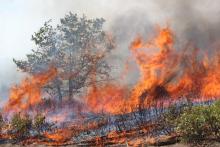Wildland Fire

Over the past several years the number and size of invasive grass induced wildland fires have grown at an alarming rate. The spread of invasive plants, especially grasses, has dramatically increased the spread of wildfire. The fire science and invasion biology communities have provided strong evidence related to the fire threats caused by certain invasive species and how the combined effects of these invasions and fires are changing fire regimes and invasive species distributions across the landscape. It is now well established that there is a feedback mechanism between invasive species and fire. For example, in the West, this is primarily a function of fire-tolerant invasive grasses spreading into landscapes which were previously much less prone to burning; where native plants did not provide a continuous bed of fine fuels but non-natives do. Hotter, drier conditions associated with changing climate make this problem more acute. These conditions, in addition to higher fuel loading resulting from a century of fire suppression, enable fires that have become larger, longer-lasting, more frequent, and more destructive in terms of lives lost and economic costs. (Source: National Invasive Species Council - Wildland Fire and Invasives)
Spotlights
All Resources
Selected Resources
The section below contains highly relevant resources for this subject, organized by source.
